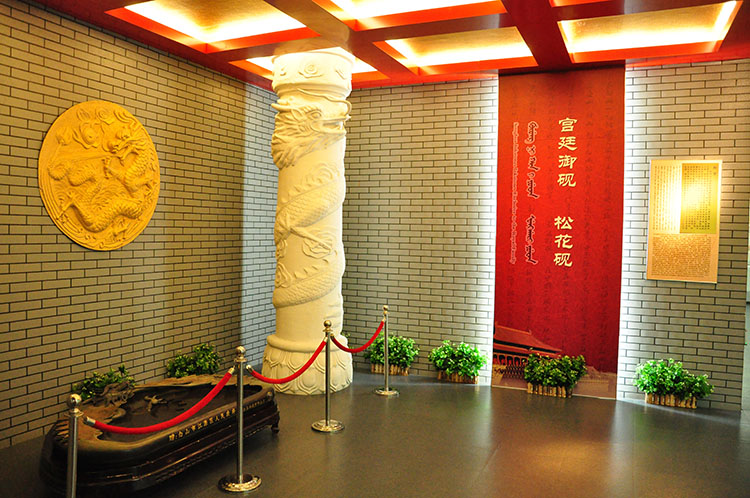
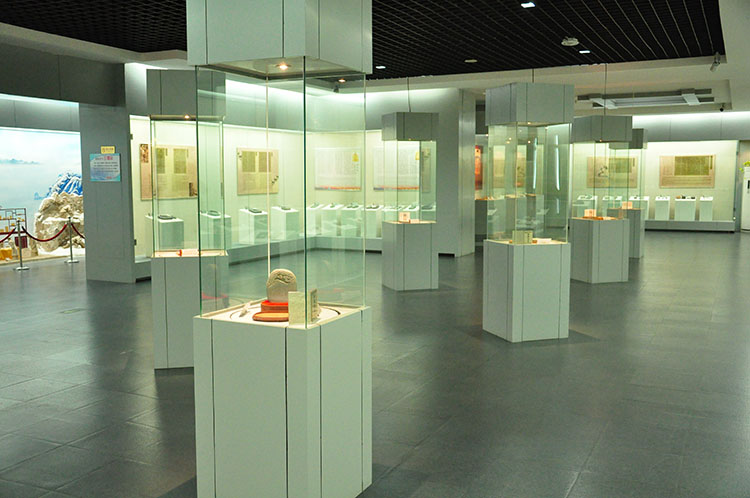
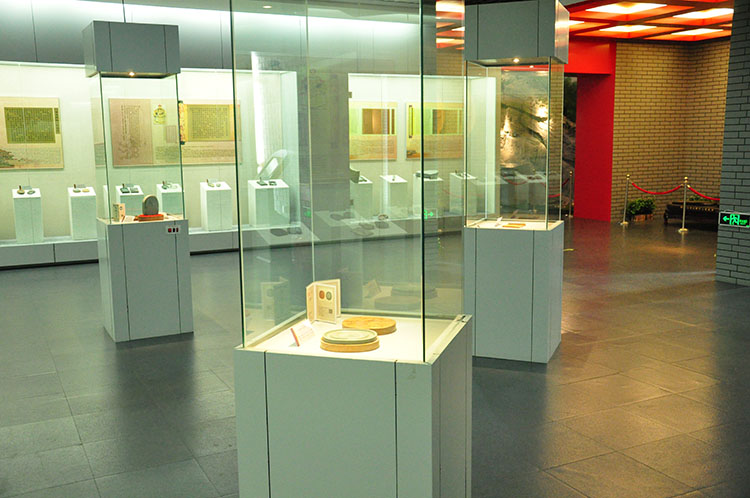
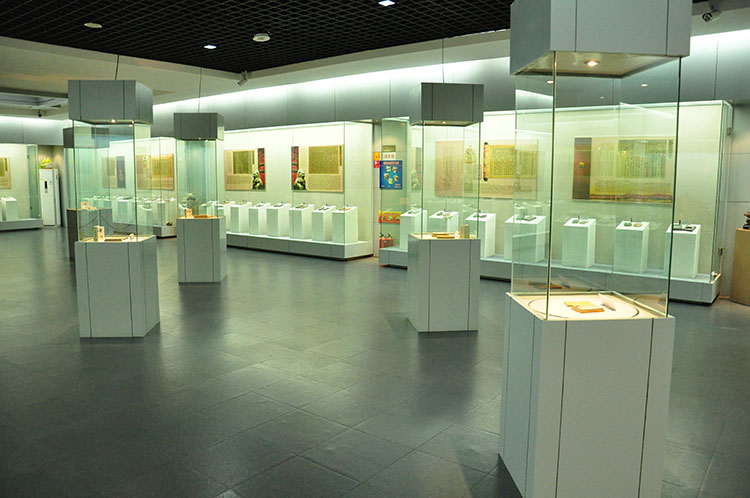
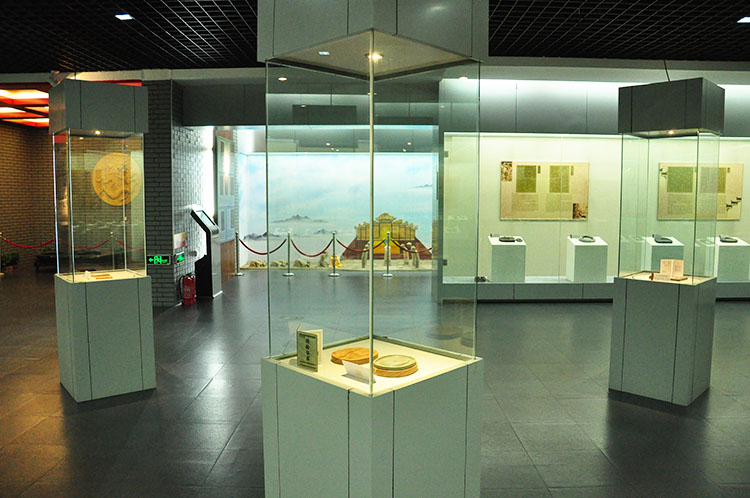
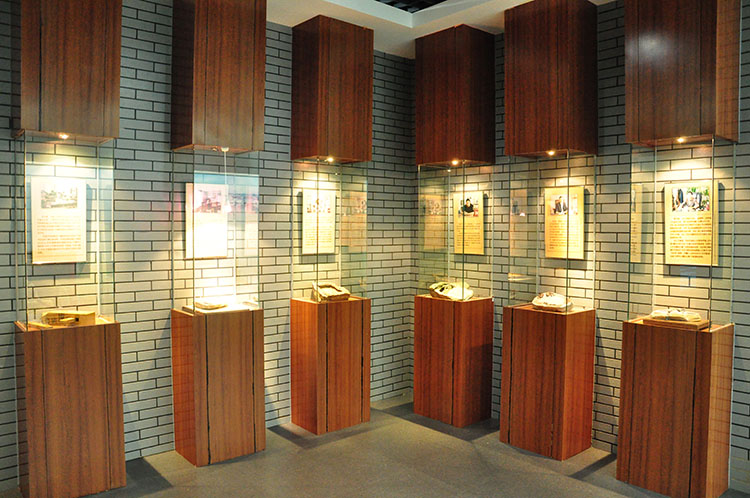
Thematic Exhibition Hall of Songhua Ink Stone
《宫廷御砚--松花砚》是松花石博物馆基本陈列之一。松花砚作为“宫廷御砚”,在中国的制砚史上,从开采、设计、雕刻到文化历史背景,都占有非常重要的地位。又因其仅供皇家专享而充满神秘色彩。康雍乾三朝帝王对松花砚更是情有独钟,将其作为教育子女、笼络大臣、治国守业的信物,并给予了高度评价。
The “Imperial Ink Stone of Court - Songhua Ink Stone” is one of the basic displays in the Songhua Stone Museum. In the history of making ink stones, the Songhua ink stone, as “imperial ink stone”, occupies a very important position from exploitation, design, engraving to the cultural and historical background. And also because of its exclusive use by the Royal, it is full of mysterious color. Kangxi, Yongzheng and Qianlong, emperors of three periods in the Qing Dynasty showed special preference for Songhua ink stone and used it as a token to educate children, win over ministers, manage state affairs, keep what has been achieved and give a high evaluation.
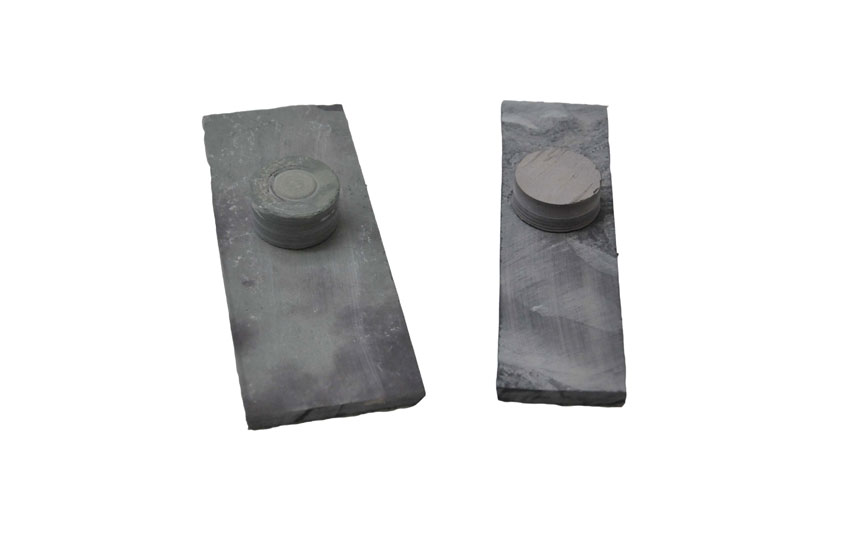
松花石千页黛板
Songhua Stone Qianye Black Plate
砚作为文房四宝之首,是承袭了研磨器这一原理发展而来。新石器时代的研磨器由磨盘和磨棒组成,先民们以此研磨粮食、中药和颜料,是当时的主要生活工具。在距今1500年前的唐朝渤海国把质地细腻的石头做成砚台,发展到清朝时期,把松花石制的磨刀石制成砚,并作为宫廷御砚一直被皇家所独享。
Ink stone, as the first of the four treasures of the study, evolves from inheriting the grinding principle of triturator. The triturator in the Neolithic was composed of grinding disc and rod mill; the ancestors used it to grind food, medicine and pigment, and it was the main tool of life. In the Tang Dynasty, about 1,500 years ago, the Bohai State made the stone with delicate texture into ink stone, and in the Qing Dynasty, the knife stone made of Songhua stone was made into ink stone and was exclusively used as imperial ink stone by the Royal all the time.
由于松花砚具有“滑不拒墨,涩不滞笔,能使松烟浮艳,毫颖增辉”等特点,再加上它产自满族发祥地长白山,倍受康熙、雍正、乾隆、嘉庆等皇帝的喜爱而成为清代宫廷御用珍品,称为“宫廷砚”、 “御砚”,被视为“国宝”。
Because Songhua ink stone has the characteristics of “being slippery without repelling ink; unsmooth without stagnating brush pen; making pine soot excellent and brush point intensifying, etc.”, and it is produced from the Changbai Mountain, the birthplace of Manchu, it was pretty loved by emperor Kangxi, Yongzheng, Qianlong and Jiaqing and became an imperial treasure of the Qing Court, known as the “Court Ink Stone”, “Imperial Ink Stone” and regarded as a “national treasure”.
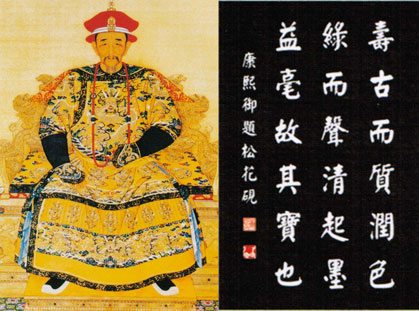
“寿古而质润,色绿而声清,起墨益毫,故其宝也。”
——康熙
“Long in history but smooth in quality; green color with clear sound; benefiting handwriting; so it is valued.”
- Kangxi
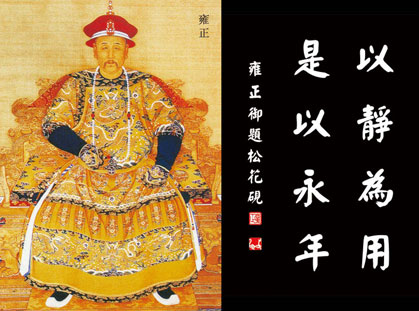
“以静为用,是以永年。”
——雍正
“Statically used, so eternal.”
- Yongzheng
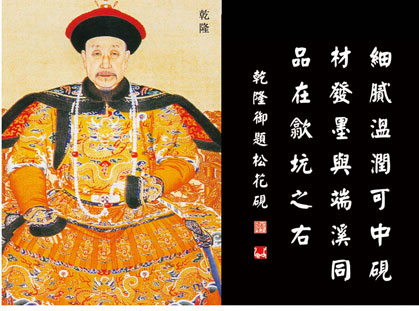
“细腻温润可中砚材,发墨与端溪同,品在歙坑之右。”
——乾隆
“Delicate and mild, it can be the material of ink stone; the ink producing is the same with those produced in Duanxi and its quality is next to those produced in Xi.”
- Qianlong
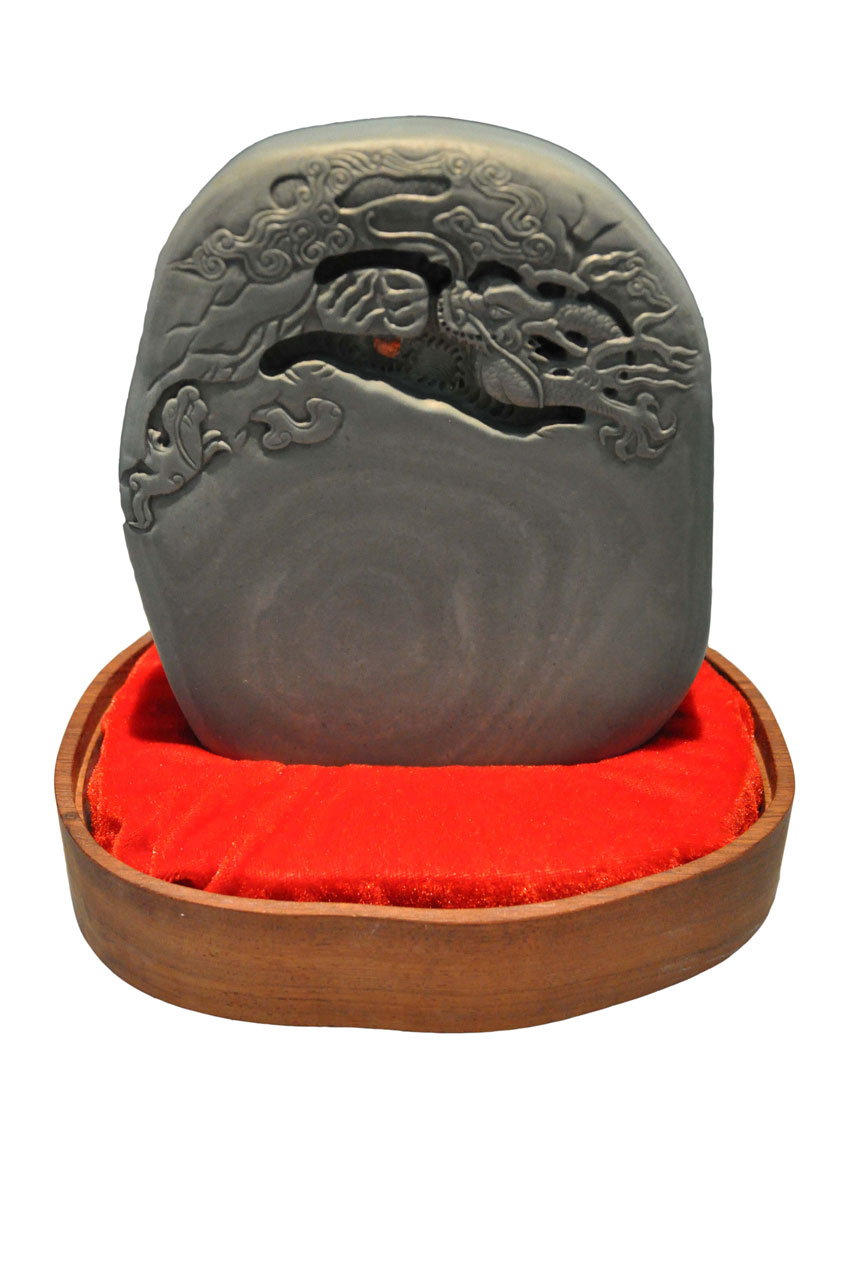
赐子砚—苍龙教子砚
Ink stone granted to the son - the black dragon taught his son with an ink stone
康熙崇儒重道,认定“理”先天地而存在。康熙五十二年在经历过二立二废太子胤礽的波折后,将四子胤祯召到御花园内,亲赐一方松花砚,砚背刻为“一拳之石取其坚,一勺之水取其净”,勉励皇子知书向上,求真务实,克难排坚,勇往直前,这便是“赐子砚”。
Kangxi respected Confucianism, emphasized Taoism and firmly believed that “truth” existed before heaven and earth. When Kangxi had been emperor for fifty-two years, after he experienced the appointment and abolishment of Yinreng, the prince, respectively two times, he summoned Yinzhen, his fourth son, to the imperial garden and granted him a Songhua ink stone with the back of ink stone being engraved “Take the hard part within a fist size of stone and take the clean water in a spoon of water” to encourage the prince to know the books, be realistic and pragmatic, overcome difficulties and strive forward, and that’s the ink stone granted to son.
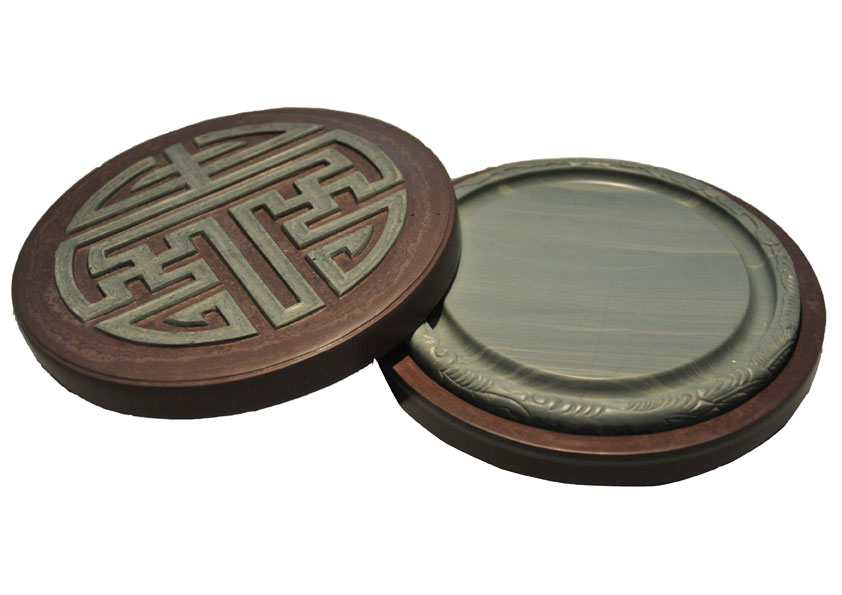
赐将砚—石鼓砚
Ink stone granted to the general – Stone Drum Ink Stone
雍正帝勤俭务实,在位期间最大的奢侈就是馈赠松花石砚了。1724年,年羹尧在平定青海战役凯旋回来后,雍正亲率满朝文武大臣到西直门外迎接,予以年羹尧破格恩赏,并赐一方新制的松花石石鼓砚。砚面雕制万寿图吉祥的图案,可以看出雍正皇帝对大将军年羹尧立下的汗马功劳给予的恩赏,表彰他为朝廷立下的赫赫战功。
Emperor Yongzheng was thrift and pragmatic. During his reign, the biggest luxury was to bequeath the Songhua ink stone. In 1724, Nian Gengyao, the general, came back victoriously after had squashed Qinghai rebellion and Yongzheng led all the ministers to welcome him outside of Xizhimen and awarded him exceptionally with a newly made stone drum ink stone which was made of Songhua stone. On the surface of the ink stone, the auspicious longevity patterns were carved, and it could be seen that emperor Yongzheng awarded Nian Gengyao generously for his achievement and commended him for his military exploits done for the imperial court.

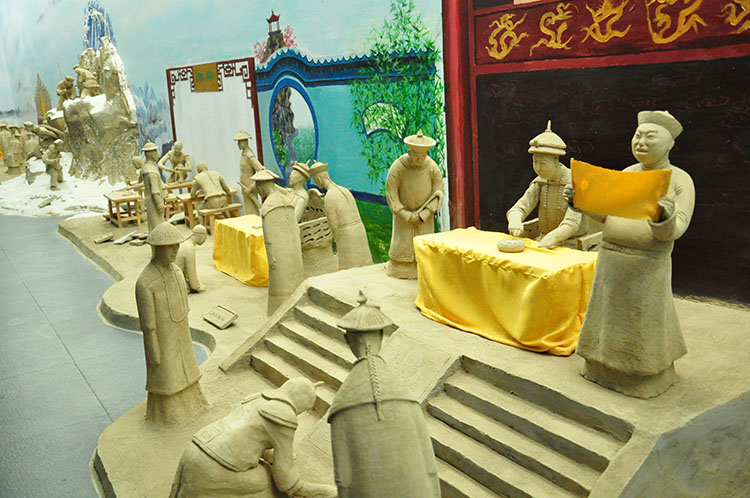
泥塑区生动地展示了清朝对长白山及松花石的崇敬与热爱
The area of clay sculptures vividly shows the respect and love of the Qing Dynasty for the Changbai Mountains and Songhua stone.